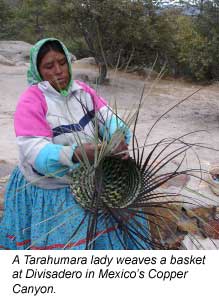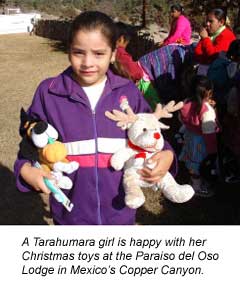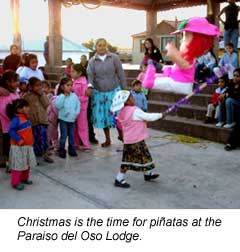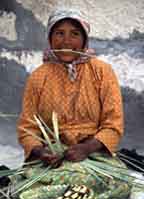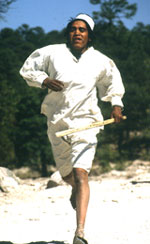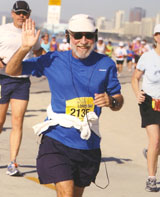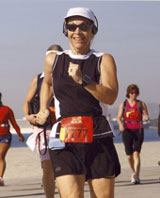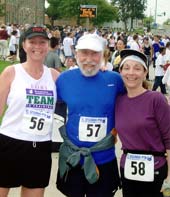On a Stroll to Satevo
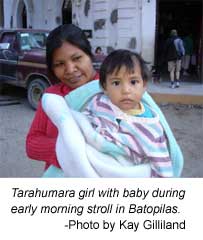
The following story was submitted to us by Kay Gilliland who describes her experience traveling with friends through Mexico’s Copper Canyon during the Christmas holidays. Here, Kay and her traveling companions explore the village of Batopilas and the mysterious “Lost Cathedral” at Satevo.
The California Native is always thrilled to have groups of friends join our trips to this charming region of Mexico. We appreciate it when our guests share their stories with us and we like to add them to our blog for everyone to enjoy. Excerpts from her journal will be posted regularly, so check back often to learn more about Kay’s 11-day Copper Canyon Adventure.
December 29, Monday
In the morning, we walked to Carolina’s Restaurant in the Plaza Constitución for breakfast. We saw the sandal maker’s shop and his stack of tires. We enjoyed a wonderful breakfast, then got ready for the walk to Satevo. One of the local dogs, Perucho, joined us for the whole walk. Along the way Jenny found a sack of cheese and Perucho devoured it. I stopped to tie my boot lace and Perucho stayed with me. All of a sudden he looked up to find Jenny far ahead. Perucho ran as fast as his legs would carry him and caught up with her.
Up ahead, we heard a lot of animal snufflings which proved to be coming from one tiny piglet. I couldn’t believe that little thing was making all that noise.
We arrived at the “Lost Cathedral” of Satevo. A woman sitting in the gazebo of the plaza was making embroidered napkins. We sat down while Jessica told us about the Cathedral. It was built in the early 1600s or maybe the 1760s but the records were lost through fire. Another name for it is “Iglesias San Miguel de Satevo” but so little is known about who built it that the name “Lost Cathedral” has stayed with it. Piled around inside the cathedral were statues, basins, and other church paraphernalia. The walls are being restored (with government money) as near to the original as possible. The Christmas manger had many additions including a giraffe. Jenny climbed the ladder into the tower of the church and out onto the roof while we took pictures.
Jessica, Jenny, Sally, Laurie and I climbed into the truck for a ride back from Satevo. At the top of the hill Jessica and Jenny got out to walk, expecting Perucho to accompany them. Perucho would have none of it. He wanted to ride all the way back. He was finally pulled out of the truck and walked the rest of the way with Jenny and Jessica.
After a shower we walked over to Doña Mica’s for lunch. This restaurant is built onto her home and she cooks everything on an old-fashioned wood-fire stove.
A young woman came to the door of the restaurant with a basket full of something in red cellophane wrappers. Jessica bought some and introduced us to a sweet candy made of Cameron. After a refreshing lunch we walked to the General Store for chocolate covered frozen bananas and cups of frozen mango.
Back at Juanita’s Place I watched life on the Rio Batopilas: women washing clothes, children playing, teens swimming and teasing each other, cattle coming for a drink, and a truck driving down through the middle of it all. Sally crossed the swaying footbridge and returned saying there were many missing and broken slats. Bill pointed out the enormous bougainvillea tree and we talked about how it could exist when we knew the plant only as a slender vine.
We walked toward the Hacienda de San Miguel. I went the long way, getting a ride from Antonio for part of it, but everyone else crossed the river on a very narrow makeshift “bridge” with lots of help from Jessica. When asked if she felt like turning back, Sally said she was determined to make it because Laurie was making it. They did make it, but it was a “one-way bridge” because Jessica did not offer to take us back that way.
The ruins were quite impressive. Jessica explained that Alexander Shepherd administered his silver empire from this site. He decided the silver mines could be profitable if the silver was processed into ingots rather than trying to ship raw ore out of remote Batopilas, and those mines made him very rich. We walked around the ruins of stamp mills, an assay office, refectory, boardinghouse, corral and stables, machine shop, iron foundry, ingot mill, and other buildings and sheds. At one time an aerial tram linked canyon slopes on both sides of the river. Several large fig trees grow on the compound walls and the tallest building is overgrown with a huge bougainvillea; Jessica said the bougainvillea is considered the largest in the world.
We came back from our walk to find the museum as well as the craft store closed. We hung out in the Main Plaza watching the kids play ball. As we walked to supper Jessica saw Señora Montes and asked her to open the store after we had dinner. She said she would be there. We ate a wonderful supper at Patio Cinco Restaurante. The tostadas of avocado and of chicken tasted especially good. Jessica took glasses from the restaurant and walked across the street to get them filled at a place with a license. When we walked back the light was on in Señora Montes’ store and she greeted us at the door. We bought butterfly rattles, drums, baskets. Jennie bought a magnificent big drum for Lori.
We returned to Hotel Juanita’s and went star gazing on the roof. We found Orion, Auriga, Canis Major with Sirius the Dog Star, the Pleiades, the Great Square of Pegasus, Cassiopea, and the Milky Way but we never saw the Big Dipper, North Star or the Little Dipper. We went back down to our room and were soon asleep.

